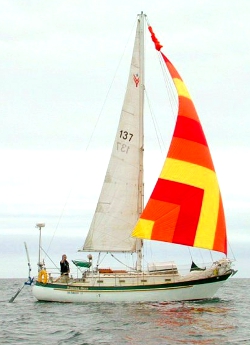Lesson: The Math of Sailboat Design
 (Lesson courtesy the Cooper-Hewitt National Design Museum Educator Resource Center and Tonya Adison). Level: High School. Time Required: Two 60-minute class periods.
(Lesson courtesy the Cooper-Hewitt National Design Museum Educator Resource Center and Tonya Adison). Level: High School. Time Required: Two 60-minute class periods.Designing the Sail of a Boat
Introduction:
Why do sailboats have triangular sails? This lesson introduces the basic postulate of right triangle trigonometry — the Pythagorean Theorem — and demonstrates how this Theorem can be tested and proved. Students learn about sailboat design and how the shape of sails affects their movement. They apply what they learn about a hands-on, engineering math lesson that requires them to design a boat’s sail. With the opportunity to explore and prove the Pythagorean Theorem, students gain a better grasp of how to take accurate measurements and how to read a standard ruler. They also exhibit creativity in designing/decorating their sailboats. Through this process, they come to understand this famous theorem.
Objectives
Students will:
- investigate the design of sailboat sails
- take accurate measurements using a ruler
- identify right triangles based on given measurements of sides
- find the missing side of right triangle
- solve word problems involving right triangles
- draw diagrams to show a visual representation of a written problem
- make connections to sailboat design
- make connections between the theorem and real world situations
National Standards
-
recognize reasoning and proof as fundamental aspects of mathematics
-
make and investigate mathematical conjectures
-
compute fluently and make reasonable estimates
-
represent and analyze mathematical situations and structures using algebraic symbols
-
analyze characteristics and properties of two- and three-dimensional geometric shapes and develop mathematical arguments about geometric relationships
-
specify locations and describe spatial relationships using coordinate geometry and other representational systems
-
understand measurable attributes of objects and the units, systems, and processes of measurement
-
apply appropriate techniques, tools, and formulas to determine measurements
-
build new mathematical knowledge through problem solving
-
solve problems that arise in mathematics and in other contexts
-
apply and adapt a variety of appropriate strategies to solve problems
-
communicate their mathematical thinking coherently and clearly to peers, teachers, and others
-
recognize and use connections among mathematical ideas
-
understand how mathematical ideas interconnect and build on one another to produce a coherent whole
-
recognize and apply mathematics in contexts outside of mathematics
Resources
Handouts:
- “How does a Sailboat Move Upwind?” – an article located at Physics.com
- Pythagorean Theorem handout (Word document)
- Sailboat Handout (ppt)
Additional:
- Regent’s exam prep center material with helpful mathematics information and material
- Task bulletin blurb.jpg (Task Bulletin Blurb)
- Did you Know- Bulletin Blurb.jpg (“Did you Know?” Bulletin Blurb)
- Bulletin board photos.jpg (Bulletin Board photos)
Materials
- rulers
- Post-its
- calculators
- markers
- crayons
- colored Pencils
- push pins/thumb tacks or magnets
Vocabulary
Right triangle–a polygon with three vertices and three straight line segment sides (a triangle) that has one 90-degree angle.
Procedures
Introduction:
Day 1
- Define a right triangle and identify the legs and the hypotenuse of the triangle.
- Provide the formula for the Pythagorean Theorem, a2 + b2 = c2, and identify a and b as the legs and c as the hypotenuse.
- Distribute the Pythagorean Theorem handout and guide the students through each of the four examples.
- Give the students about 10-15 minutes to work on the Student Practice problems.
- Invite a few students to put their answers to the problems on the board and explain their work to the class.
- Ask students if they agree with the work on the board and if they solved the problems in a similar fashion.
- Answer any remaining questions about the problems.
- Tell the students that they will be using the information they learned today to design sailboat sails in the next lesson.
Day 2
Introduce the activity as a follow-up to the previous day’s work, explaining that the class will conduct an experiment to determine if the Pythagorean Theorem really works. “We have learned about sailboat design and learned how to calculate the missing side of a right triangle, but how can we be sure this is true?”
- Distribute Sailboat Handout, rulers, and two post-its to each student.
- Instruct each student to measure 2 sides of each of the triangular sails on the handout and record their answers on their post-its.
- Students calculate the measure of the third side of the triangle using the Pythagorean Theorem.
- Students then measure the third side of the triangle and compare their answer to the one they got in the previous step.
- Students record and summarize what they notice.
- Students decorate their sailboats as they choose and write a brief summary of why their sailboat sail design works.
Wrap-up
Depending on your classroom, allow students to display their work for a “gallery walk” where they are able to see what other students created.
Assessment
Enrichment
Extension Activities:
Author: Tonya Adison
Filed under: Grades 9-12, Lesson Plans
Tags: Geometry, Grades 9-12, Lesson Plan, Mathematics, Nautical Engineering









